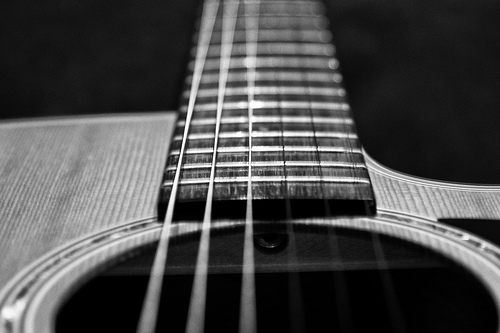Why a Guitar Needs Stringing
There are several reasons an acoustic guitar might need restringing. If one string snaps, then it is advisable to replace all of them, while intensive use of a guitar may also mean that the instrument needs to be restrung.

Restringing Your Guitar
Once you have decided that your guitar needs restringing, it is time to begin. What should you do?
Buying New Strings
Buy strings from a specialist music store. This way, you will be able to have 100% confidence in what you’re buying.
Removing Existing Strings
Ensure you have plenty of space, and lay your guitar on a flat, clean surface.
Starting with the bottom string (the low E), unwind the turning tuner to loosen the string and eventually remove it from the hole in the tuning peg completely.
It is up to you whether you swap one string at a time, or completely remove them before replacing. If you opt for the latter so that you can polish up your fret board, for example, be careful of damaging the bridge or neck of the guitar, and look to keep both as still as possible.
Once you can see the end of the string, pull it from the hole in the tuner. The final part is to remove the bridge pin that will enable you to remove the other end of the string. Using bridge pin pullers from a music store will ensure you don’t damage either the pin or the guitar.
Having removed the bridge pin, pull out the string and throw it away. If you’re taking them all out at once, then repeat before moving on. If not, continue.
Maintenance Work
Polish and clean as you go, remove any dust or debris from around the bridge as well as the turning tuner before replacing each string. Again, use specialist guitar polish and a cloth.
Replacing the Strings
With guitar shiny and new, you can start placing your new strings onto your new looking guitar. If you’ve removed them all at once, then begin with the sixth string once more. Having opened the packet and unwrapped the first string, you are now looking for a small ball on one end of the string.
Place this end a few inches through the hole you created when you removing the bridge pin. Start to replace the bridge pin, and tighten the string until you feel the ball falling into place, at which point you can push the bridge pin all the way in.
Take the other end of your string to the top of the guitar and place it through the hole in the tuning peg. Continue to feed the string through the hole before starting to tighten.
Tuning Your Guitar
Once your strings are all fitted, it is time to tune them. Guitar fully tuned, you can then cut down your guitar strings, unless you are going for the ‘busker look’ and are happy to have them flaying around while you play. Just be sure to leave enough string for you to retune to a deeper tone should you wish to do so.
Image Source: TschiAe
Are you a guitarist? Check out our full range of online guitar lessonsAre you a saxophonist? Check out our full range of online saxophone lessons
Subscribe to Pro Music Tutor from as little as £7.99 per month
Related Posts
-
Why You Should Be Learning a Second Instrument
Learning your first instrument can sometimes feel impossible. Why on earth would you want to learn a second? I’m going to use this article to convince you that learning a second instrument is not only a great use of your time, but it may be better than spending time with your first instrument! Considering the […]
View All >> -
5 Easy-to-Learn Guitar Riffs to Impress Your Friends
When you’re first starting out learning how to play the guitar, it can be quite frustrating to stay motivated. It’s practicing the same chords, the same strumming and fingerpicking patterns, the same scales and songs over and over. It’s also pretty hard to impress your friends or girls with your noob skills, so ultimately you […]
View All >>
Latest Blog Entries
-
The Benefits of Online Music Education
Learning music has never been easier, since the internet and modern technological advancements have opened the doors to countless possibilities, expanding the subjects people can choose from and how the lessons are taught. Now, people can study a whole host of music-related topics; from learning to play guitar or DJing, to understanding the inner workings […]
View All >> -
Essential Jazz Guitar Scales that are Easy to Learn
Improvising in jazz requires the ability to play in different keys over different chords. Results certainly do not come overnight, but with diligent practice, you would be surprised by what you can achieve. Many people ask me about what scales I use as if they were some big secret. While knowing your scales is very […]
View All >>
Blog Categories
- Categories
- Guitar Tips (93)
- History (36)
- How-To (38)
- Interviews (3)
- Music Industry (121)
- Prolinks Guitar (2)
- Prolinks Lessons (3)
- Prolinks Tutor's Profile (1)
- Saxophone Tips (40)
- Uncategorized (6)
Tags
Archive
- November 2018 (1)
- February 2018 (1)
- December 2017 (1)
- November 2017 (1)
- October 2017 (1)
- July 2017 (4)
- May 2017 (2)
- April 2017 (1)
- August 2016 (2)
- July 2016 (1)
- June 2016 (2)
- May 2016 (3)

